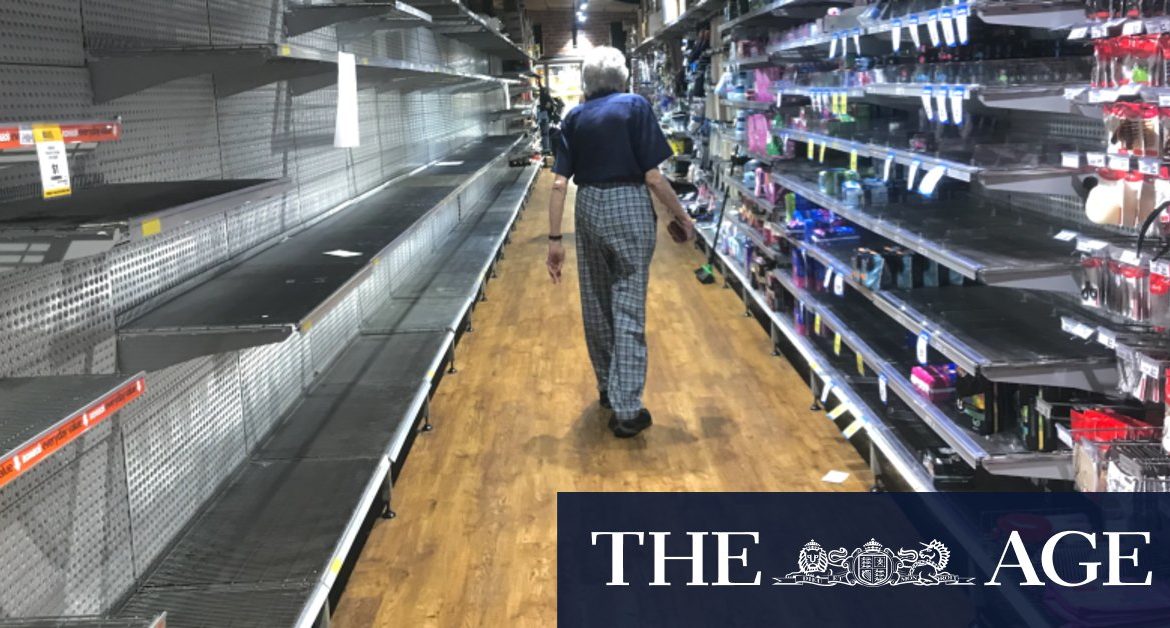Soon after this year’s great Australian supermarket stampede began in March, Prime Minister Scott Morrison issued an SOS to his Vietnamese counterpart, Nguyen Xuan Phuc.
Rice was among the staples emptying fastest from supermarket shelves, the drought had already impacted local growers, and Morrison wanted to be sure Vietnamese rice would be available to bolster dwindling supplies, both here and for our Pacific neighbours.
In a phone call to Phuc in early April, he sought an assurance that Australia’s access would not be threatened by the blanket slowdown Vietnam was placing on its own exports of the grain. It was an assurance, it’s understood, Phuc was willing to give.
Meanwhile Home Affairs Minister Peter Dutton was staging an unusual intervention of his own. The heads of Australia’s major supermarket chains were struggling to cope with the soaring demand for household staples.
Top executives at the retailers wanted a way to co-ordinate their efforts, but were petrified their high-level talks could fall foul of the nation’s strict competition laws.
A huge increase in household consumables purchasing has seen shelves stripped here and abroad. Credit:Louise Kennerley
Dutton came over the top with a simple edict. Get on the phone, he told the supermarket bosses. Talk to each other, and he would take care of the Australian Competition & Consumer Commission. A day later, the supermarket taskforce was born, bringing together top-level executives from Coles, Aldi, Woolworths and Metcash. The signal from government was clear: collaborate as much as you need, keep the country fed.
Such interventions might seem unremarkable now at the end of a year replete with remarkable events. But both typified the speed at which old rules had to be torn up, and new ones devised as politicians, senior bureaucrats, health leaders and industry bosses wrestled with the massive disruption unleashed by COVID-19.
As well as the threatened chaos in retail, the country was learning a painful lesson about the vulnerability of its manufacturing sector. The mothballing of entire fleets of aircraft around the world, together with the economic chaos unleashed by the virus in the early stages of the pandemic, created havoc with international supply lines.
“When China shut down, suddenly everything you could think of, down to nuts and bolts, came to be in short supply,” says Innes Willox, chief of the Australian Industry Group. “We didn’t have capacity around making syringes and needles for instance; we did not have a capacity to make Ventolin (a vital reliever for asthmatics)”. Australia didn’t make surgical gloves, the government learned, and still doesn’t to this day.
Health Minister Greg Hunt and Industry Minister Karen Andrews found themselves on the phone for hours at a time, trying to ensure yawning gaps were plugged.
“Our biggest risks were masks and personal protective equipment [PPE],” says Hunt. “We set up procurement units in the Department of Industry and Department of Health… we had to bring in finance, we had legal, we had logistics, we had quality assurance, all of those things built into it. We also knew there was a massive risk of a global supply shock downwards, and a global demand spike upwards, and that if either of those broke, we would be at massive risk.”
Defence Force engineers were called in to boost the capacity of the country’s sole manufacturer of surgical masks, a small outfit called Med-Con, near Shepparton in Victoria, at that stage producing only a fraction of what the nation needed.
Australia’s then sole maker of ventilators, Sydney-based ResMed, was finding its critical supply lines under extreme pressure as well. The company manufactures for export as well as the domestic market, and its sophisticated life support ventilators, made at its factory in Bella Vista in Sydney, drew on a complex international supply chain which sourced components from 11 different countries.
“What started as a health crisis in China, the rest of the world experienced in the first instance as a supply crisis,” says Brendan Mullins, ResMed’s Vice President of Global Manufacturing and Engineering. “During the Chinese New Year, everything stopped [and] it was a challenge to keep our factory doors open.”
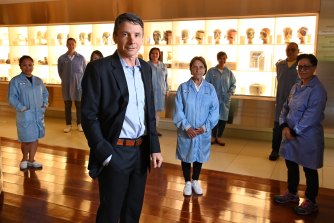
ResMed’s Vice President of Global Manufacturing and Engineering, Brendan Mullins with his team.Credit:Nick Moir
The company rode out the first part of the crisis until China got on top of its outbreak. But the next obstacle was “rolling stoppages and closures round the world”, compounded by the soaring costs of airfreight as air fleets were grounded.
Yet demand for the company’s products was soaring. “We work in 140 countries. How many asked for ventilators? Probably 140,” Mullins says.
ResMed met in early March with Andrews and Hunt to assess Australia’s needs. The entire country had about 2000 ventilators but if the virus was going to spread here as it had overseas, many thousands more were needed. Within a week the ventilator task force had been formed.
ResMed overcame its supply chain challenges with what Mullins calls “brute force”, armed with a letter from the then acting head of the health department, Caroline Edwards.
Addressed to “whom it may concern”, the letter authorised ResMed to represent the government in talks with overseas suppliers and manufacturers for any procurement related to the supply of ventilators to combat the pandemic. By August, the company had supplied another 7000 ventilators to the Australian government.
In Victoria, the Andrews and Morrison governments supported a consortium brought together by Grey Innovation, a company that specialises in commercialising medical device technology. Starting from scratch, the group obtained the licence to a British ventilator design and created a local supply chain for all components except computer chips, delivering another 1700 locally made ventilator units.
“It was an amazing response; people who might have routinely considered each other to be in competition were working in complete co-operation”, says Grey Innovation CEO Dr Peter Meikle.
In the retail sector Australia’s supermarkets acted on the green light they’d been given by Dutton and co-operated in unprecedented ways. They took out joint advertisements calling for calm, brought in shopping hours reserved for the elderly and shared supply lines to provide for remote Indigenous communities.
Working 18-hour days at the pandemic’s peak, senior executives fielded calls from Morrison, Treasurer Josh Frydenberg, and fellow leaders in the ASX200, offering support for the seemingly Sisyphean task of feeding a panicked population.
Brad Banducci, the head of supermarket giant Woolworths, found himself taking a call from Frydenberg on toilet paper sales.
Morrison’s daily hook-up with key ministers and officials had a triple focus: the health front, the economy, and supplies.
At senior levels of government there were discussions about how to organise the delivery of a “basics box” for up to a million vulnerable households a week, especially to the elderly, should that become necessary. “We were looking at what we called a ‘reasonable worst case’,” a senior government source says, “hoping gee, I hope we never have to use this.”
In a sector usually best with fierce rivalries, Banducci and his counterpart at Coles, Steven Cain, had nightly phone calls for nearly a month. “Eventually Steve Cain and I said, ‘We’ve got to stop talking’,” Banducci jokes. “I was speaking to him every night at 5.00 for 30 minutes… Australia was at a fork in the road, in terms of how the community transmission could play out.”
Banducci says grocery supply lines proved ultimately more resilient than first thought, helped by the fact that Australia sources 90 per cent of its fresh food from within the country. But in future he’s committed to a greater focus on sourcing and stocking Australian-made products. “We’re trying to make sure we have as compelling an Australian-made offer as possible outside of fruit and veg and into other categories,” he says. “That’s going to be a major change for us.”
That will require more sourcing from smaller suppliers, similar to what independents such as IGA do, an arrangement the chief executive hopes will benefit both the supermarket chain and some COVID-battered smaller operators.
The big retailers also discovered that in the midst of a pandemic, there’s a downside to highly automated warehouses, geared to run on a “just in time” model. The massive surge in demand was creating bottlenecks, so the supermarket giants reverted to manually operated “overflow” warehouses during the wave of panic-buying.
Manufacturing matters
The profound shock to the international trading system was an abrupt wake-up call. “Manufacturing had been taken for granted and its importance to the development of a complex economy lost by policy makers”, Willox says. “If there’s any silver lining to COVID, it’s that the government is again focused on manufacturing capacity.”
In October, Prime Minister Scott Morrison and Industry Minister Karen Andrews unveiled a $1.5 billion “modern manufacturing strategy” for Australia, focusing on what were identified as half-a-dozen priority areas. These were medical products, food and beverage manufacturing, resources and critical minerals processing, clean energy and recycling, and the defence and space industries.
Canberra earmarked another $107.2 million for a so-called “Supply Chain Resilience Initiative”, which Karen Andrews says will identify gaps in the supply chain and “take action to address them”.
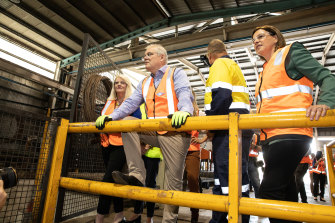
Prime Minister Scott Morrison with Federal Minister for Industry, Science and Technology Karen Andrews (left) and Qld Opposition Leader Deb Frecklington (right) on a visit to Neumann Steel Fabrication on the Gold Coast.Credit:Paul Harris
“COVID really demonstrated for us where our expertise lies,” she told the Herald. “It is time for us to be very strategic as a nation, about where we’re headed, why we’re headed there, and how we are going to do it.”
But unions say while the shift in government rhetoric is welcome, there is not enough substance to it. AMWU national secretary Steve Murphy says the Morrison government should abandon its plan to spend billions on a gas-led recovery and “commit to a manufacturing-led recovery instead”.
One early beneficiary of the new focus on national self-reliance is global biotech giant Australian-born CSL Limited.
The federal government has struck a $1 billion 10-year vaccine supply deal with CSL which will help support construction of a new manufacturing facility at Tullamarine airport for the company’s Sequiris arm, which makes influenza vaccines for domestic and overseas markets.
Two of the four COVID-19 vaccine candidates for which Australia has placed advance orders – a University of Queensland contender, which is still being trialled, and the AstraZeneca/Oxford University vaccine – can also be made by CSL at its existing Broadmeadows plant in Melbourne.
However the newer mRNA vaccines, such as the Pfizer product now being rolled out in Britain, cannot at this stage be made locally.
On the retail front, the industry expects to see lasting changes from the way the pandemic has altered shopping habits.
A greater focus on hygiene, especially when dealing with fresh fruit and veg, is one. More shopping during the week with a smaller number of items purchased also appears to have replaced the classic big weekend shop.
Tim MacKinnon, the Australian head of e-commerce giant eBay, believes the pandemic has also made Australians more impulsive, more impatient, and more interested in buying local.
“All of these things have been going on, they’ve just accelerated more during COVID. And the longer we’re in this period, the more those habits will become entrenched,” he says. “I don’t see this snapping back to normal.”
Shopping in the local neighbourhood is also back in vogue, with suburban supermarkets and small-format IGA and independent stores finding favour over inner-city shops.
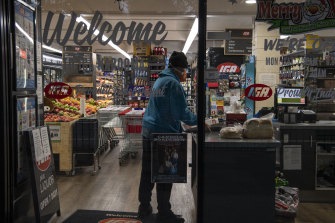
Early morning shopping at a local IGA in Narooma.Credit:Louise Kennerley
Independents are hoping to make hay while the sun shines. Fred Harrison, the chief executive of one of Australia’s largest independent supermarket chains, Ritchies, says this presents a huge opportunity for local stores and smaller grocers, though he fears shoppers may gradually drift back to old habits and seek cheaper, imported produce. “History tends to repeat itself,” he says.
Another predictable by-product of the pandemic has been the rapid boom in online sales for housebound Australians, flush with stimulus money.
It’s meant big business for operators such as eBay, Kogan, Amazon and Catch, but the rising tide has also boosted the sales of more traditional bricks and mortar operators like Myer and Bunnings.
Analysts expect online will make up 20 per cent or more of all Australian retail sales within the next five to 10 years, cementing the sector as a roughly $50 billion industry.
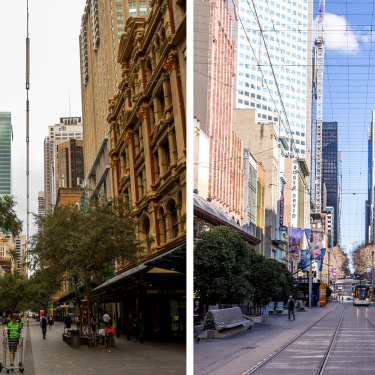
Left: Pitt street mall in CBD in Sydney in April. Right: Melbourne CBD in July. Credit:Christopher Pearce, Wayne Taylor
It’s one of the largest and most profound changes wrought by the pandemic, and is likely to have broad knock-on effects for shopping centres, logistics networks and even the labour market.
As growth in the digital sector drives 20 per cent of spending online, the value of major shopping centres could drop by as much as 30 per cent, according to recent research by property advisory firm PAR Group.
This could lead to a number of store closures across shopping malls, especially in regional locations.
They will likely be replaced by more ‘experience’-focused sites, according to Mitch Bittermann, consultancy firm TM Insight’s head of e-commerce.
Loading
“We predict a similar trend to what we see in Japan, Korea, Singapore and China, where malls of the future are not only consisting of classical bricks and mortar retail but rather ‘experience stores’ where consumers are entertained before they actually purchase a product,” he says.
These days, Woolworths chief Banducci says the frantic days of March and April feel like another world. Now it’s “back to competition” he says, but when it counted “we were there for the collective good”.
You can read other stories in our series here.
Get our Coronavirus Update newsletter
Stay across the news you need to know related to the pandemic. Sent Monday and Thursday. Sign up here.
Deborah Snow is a senior writer for The Sydney Morning Herald.
Dominic Powell writes about the retail industry for the Sydney Morning Herald and The Age.
Most Viewed in National
Loading

